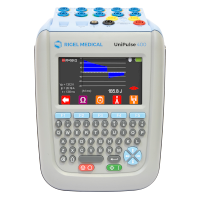External defibrillators provide high levels of energy to the heart of a patient after uncontrolled contractions of the heart muscles occur. The energy briefly stops the heart and the natural heart rhythm restarts on its own. The purpose of defibrillator testing is to ensure basic safety and accuracy conformances e.g. accurate defibrillator energy output in to various loads.
There are two types of external defibrillator; basic life support (BLS or AED) and advanced life support (ALS). BLS defibrillators, more commonly referred to as automatic external defibrillators (AEDs) can be operated by anyone. Algorithms accurately evaluate cardiac rhythms and automatically permit a shock. ALS defibrillators are comprehensive devices used by medically trained personnel and provide pacing, vital signs monitoring and other optional features.
Defibrillator testing procedures vary according to manufacturer, however there are set essential requirements in the current IEC 60601 standard.
ALS defib performance testing includes the following tests:
- Defibrillator energy output measurements (Energy output measurements ensure that patients receive the required amount of energy. Too high and the heart muscles can be damaged, too low and defibrillation may not occur)
- Transcutaneous pacing pulse rate, current and duration measurements (Pacer rates often need to be synchronised with the natural rhythm of the heart)
- Maximum delay time from the synchronized peak QRS complex to the peak delivered energy (Ensures a shock does not occur during the sensitive phase)
BLS defib performance testing includes:
- Defibrillator energy output measurements
- Differentiation and identification of shockable and non-shockable arrhythmia (Non-shockable arrhythmias require CPR or drug administering for resuscitation)
- Maximum delay time from the synchronized peak QRS complex to the peak delivered energy

















Sign up to our Newsletter.
Stay up to date with the latest industry and product news, as well as our free educational content such as webinars and our expert guides.
Close